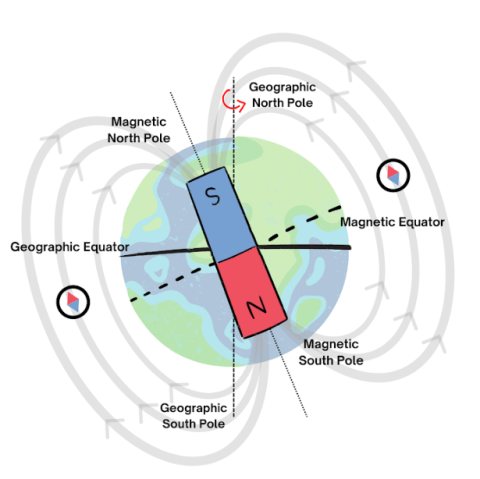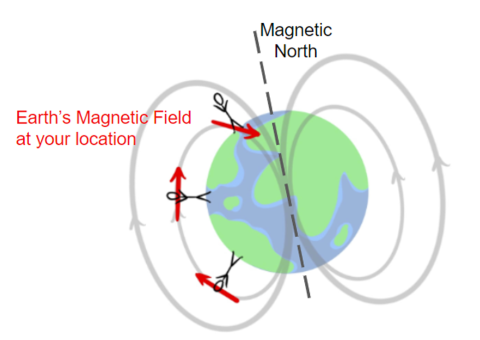MagnetiSiM 2022

Event Menu
This year marks the 300th anniversary of the measurement of the Earth’s magnetic field daily declination by George Graham and the 190th anniversary of Gauss' measurement of its intensity. Join us around the world in commemorating this event by measuring the Earth’s magnetic field at your location!
Introduction
The Earth’s Magnetic Field
Our planet Earth is surrounded by an immense magnetic field that extends from Earth’s interior into space. The origin of Earth’s magnetic field is still not fully understood, but it is thought to be a result of the molten iron and nickel in Earth’s outer core. This mixture generates electric currents due to natural convection thanks to the heat escaping from the Earth’s core. This effect is known as dynamo effect or geodynamo and explains why the Earth’s magnetic field is sustained.
Earth’s magnetic field at its surface can be approximated as a magnetic dipole placed in the centre of the planet, forming two poles: the North and the South. These poles have opposite positive and negative polarities, like a bar magnet. However, this bar magnet is slightly tilted with respect to the Earth’s rotation axis, which means the geographic and magnetic poles are not located in the same place. Additionally, the North and South magnetic poles slowly and continuously move over.
Interestingly, what we know as ‘Magnetic North’ or ‘Magnetic North Pole’ that is situated in the geographic north represents the South pole of the Earth’s magnetic field. Contrarily, the ‘Magnetic South’ or ‘Magnetic South Pole’ situated in the geographic south pole corresponds to the North pole of Earth’s magnetic field. As opposite magnetic poles attract, the north end of a magnet will point towards the south pole: A compass needle (north pole) will always point to the Earth’s South magnetic field, which is the Magnetic North situated close to the geographic Earth’s North Pole.

Earth’s magnetic field is not static but dynamic and can change for short or long periods. During magnetic storms, for example, it can change quickly. The magnetic field acts as a shield from the charged particles emitted by the Sun, known as the solar wind. When hitting the Earth’s atmosphere, it excites the oxygen, nitrogen and hydrogen atoms, causing the beautiful aurora. Depending on the pole, they are known as aurora borealis (north) and aurora australis (south). Long-term changes occur when Earth’s magnetic field reverses: magnetic north and south poles swap locations. Pole reversals are common in Earth’s geologic history. This event happened 183 times in the last 83 million years, every 300,000 years or so, with the last one taking place about 780,000 years ago.
Introduction
Measure the Earth’s magnetic field
Little was known about magnetism and Earth’s magnetic field until last centuries. However, early observations of magnetic materials date back to the ancient Greeks and Chinese who observe how some stones attract each other. In 1600, William Gilbert published “De Magnete”, the book considered as the starting point for the scientific study of terrestrial magnetism. Thanks to his experiments, Gilbert concluded that the Earth itself was a giant magnet.
Magnus magnes ipse est globus terrestris. (The Earth itself is a great magnet.)
— William Gilbert, De Magnete
In 1835, Carl Friedrich Gauss was the first to measure the Earth’s magnetic field strength, which ranges from less than 25 microteslas (µT) around the middle of the globe to over 60 µT around both magnetic poles. Other standard units used are Gauss, being the Earth’s magnetic field strength of around 0.25 to 0.60 G.
However, a complete representation of the Earth’s magnetic field at a given location requires a vector with three coordinates, that can be Cartesian (north, east, and down) or spherical (declination, inclination, and intensity). With the latter, the direction of the North magnetic pole can be obtained using a compass. Its relative angle to the true North pole is the declination. The inclination is the angle the field makes with the horizontal when facing the magnetic North.

A British watchmaker, George Graham, was the first one to note rapid changes in the magnetic declination of the Earth’s magnetic field 300 years ago. Since then, there was growing evidence that the Earth’s magnetic field exhibited some disturbances on short time scales. Since then, many scientists have been doing daily measurements of the Earth’s magnetic field in different locations. There are different observatories with very sophisticated instruments, such as satellites around the world in charge of monitoring Earth’s magnetic field. For example, INTERMAGNET (International Real-time Magnetic Observatory Network) is a world-wide consortium of institutes operating ground-based magnetometers recording the absolute level of the Earth's time-varying magnetic field. However… Do you know we can measure Earth’s magnetic field with a simple smartphone? Join us, SiM, on creating our own world-wide consortium that measures the Earth’s magnetic field. MagnetiSiM 2022 will offer you the instructions to measure these values and share it with all of us.
Thank you for contributing your calculated Earth’s magnetic field values!
Stay tuned for more events and prizes coming your way! Let’s keep in touch through twitter and our mailing list, which you will can subscribe to by providing your email address in the earlier form, or by dropping us an email at (Click to show email). See you soon and we hope that you had fun learning!
We would also like to thank you partners in the respective universities for their assistance and collaboration on fulfilling this event! Thank you!
Cheers,
The SiM Committee
